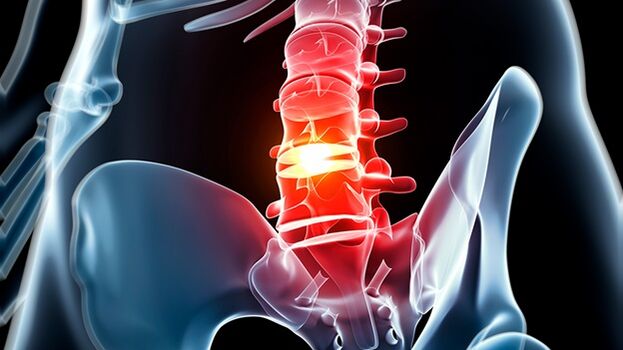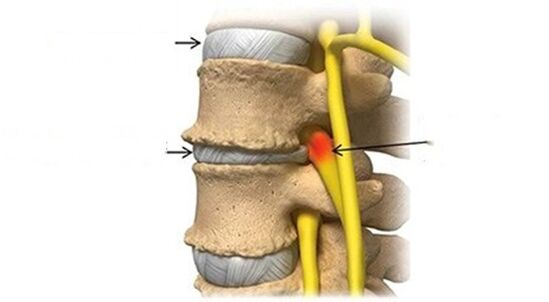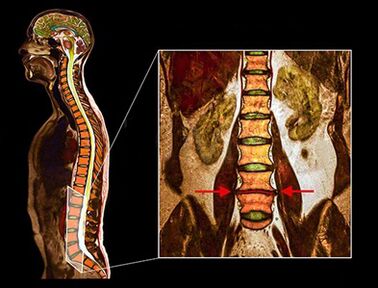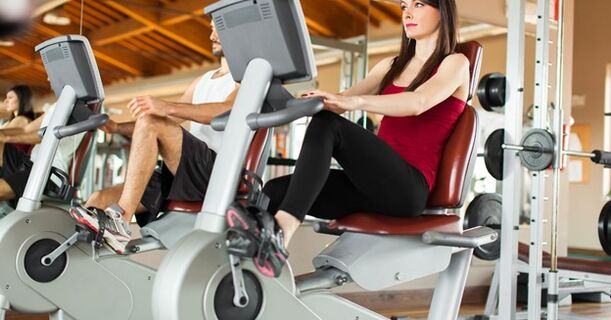Osteochondrosis (degenerative discs) in the lumbar spine or lower back is due to involuntary changes in the disks, leading to pain in the lower back.
The intervertebral discs are solid, fibrous structures that act as ligaments between the vertebrae, absorb strokes and provide shock absorption of the spine.The discs are elastic but strong enough to facilitate movements by tilting the body, forward, back or on the side.
Despite the name, osteochondrosis is not considered a real disease and the symptoms over time, as a rule, do not worsen.Discs, as well as all structures of the body, degradation and degeneration of the disc, develop in all people as part of the involution process.
A characteristic characteristic of osteochondrosis is a gradual decrease in symptoms as the spine begins to stabilize.The treatment of osteochondrosis of the lumbar spine is focused on minimizing pain, stabilizing the spine and improving or maintaining mobility.
Symptoms

Most cases of manifestation of osteochondrosis of the lumbar spine are to have mild, constant back pain, which occasionally increases for several days or more.
Symptoms may vary, but the most characteristics include:
- Moderate, constant lower back pain.Pain in the damaged disc is the most common symptom of disc degeneration.The pain can spread to the ass, groin and upper thigh.This pain is usually felt as dull and intensity can range from light to severe.
- Periodic acute episodes of pain.Back pain can be exacerbated for several days or weeks and then return to a more measured level.The outbreak of pain occurs as degeneration and disappears as the spine gradually stabilizes.The outbreak of pain can occur suddenly and the manifestations of pain often lead to a decrease in mobility.
- Local soreness.The lower back around the degenerated disc can be sensitive to the touch.Local pain is caused by inflammation and muscle tension in the area of the disk damaged by degeneration.
- Pain in the legs.Neurological symptoms, including numbness, weakness or acute, pain in the firing in the ass, thighs and / or back of the leg, can be felt if the height of the disc is significantly reduced and the conditions for compression of the nerve root arise.Leg pain with osteochondrosis of the lumbar spine does not usually fall below the knee.
- Feeling sudden weakness or instability can occur with a significant weakening of the disk and the patient creates that the lower back does not perform its functions incompletely.
In addition, the pain may be exacerbated or decreased when performing some movements or certain postures, such as:
- Seat pain.Sitting for long periods often causes increased pain and stiffness in the lower back and decreases after the onset or change of position.
- Strengthening the pain with tilting or rotation.Curbing the spine and tilt forward, back or sides can cause intense pain in the damaged disk.
- Reducing the pain of walking or changing position.When the spine changes position, the pressure on the discs decreases or is redistributed from disks to muscles and joints.Common positions, alternation of standing and sitting, as well as short walks can help reduce stiffness and minimize pain.
Disk degeneration should not cause symptoms of intestinal dysfunction / bladder, fever with back pain, unexplained and rapid weight loss or intense abdominal pain.These symptoms show more serious conditions and often require surgical treatment methods.
Related symptoms
With osteochondrosis of the lumbar spine, other symptoms associated with disc degeneration may occur in addition to lower back pain.For example:
- The proteins contained inside the disc can cause significant inflammation if they come in contact with the surrounding spinal structures, and this inflammation can lead to spasms of the lower back muscles, as well as radial pain, radiation in the hips and on the posterior surface of the lower limbs (also called Ishi).
- Lumbar disc degeneration can contribute to the development of lumbar stenosis and / or lumbar osteoarthritis, as well as to other conditions in the lower back.
- A degenerated disc can also lead to the appearance of hernia of the lumbar intervertebral disc.Neurological symptoms with disc herniation can be acute and intense.
- Symptoms caused by the disk degeneration in the lumbar spine can vary greatly depending on how quickly or completely the disc has suffered degeneration and how it affects the surrounding spinal structures.
- Osteochondrosis pain is usually caused by deformity of the muscles that support the spine and inflammation around the structures near the disc to the disc.
The causes of osteochondrosis of the lumbar spine
Osteochondrosis occurs due to age wear and disorders of the disc structure and the degeneration process can be accelerated due to injury, general condition, health and lifestyle, and possibly genetic predisposition to the development of pathological processes in the musculoskeletal system.

Osteochondrosis rarely begins with a serious injury, such as a car accident.It is more likely that the initiation of degenerative processes is associated with low -energy disc injury.
The legal pain associated with lumbar osteochondrosis is usually generated by one or more pathological processes:
- Inflammation, disc protein is irritated by the surrounding nerves - both small nerves in the disc itself and potentially large nerves that go to the legs (the sciatic nerve).
- The abnormal instability of the micro, when the outer rings of the disc, called the fibrous ring, are worn and cannot effectively absorb power vectors on the spine, leading to movements in the spinal segment.
- For a long period of time, pain in osteochondrosis of the lumbar spine eventually decreases and does not worsen.This relief of pain occurs because the disc, completely damaged by degeneration, no longer has inflammatory proteins (which can cause pain) and the sleeping disc is in stable position, eliminating the micro-movement that causes pain.
Risk factors
The factors of life of life, which affect the general state of health, can affect the intervertebral discs.The risk factors of degenerative disk disease (osteochondrosis) include:
- Family history of back pain or skeletal and muscle disorders
- Excessive load on the bottom of the back due to sports or the nature of the work
- Long static drive loads due to prolonged seats and / or bad stand
- Lack of maintenance disks due to weak back muscles
- Obesity
- Smoking or any form of nicotine consumption
Disk degeneration is part of body aging, but not all people develop pain or any special symptoms.Symptoms tend to occur in the event of instability, muscle tension and possibly irritation of the nerve root.
Diagnostics
- The history of the disease involves a detailed study of the symptoms in the patient, their intensity and the relationship of pain with the stress or the position of the body.Information about regular physical activity, sleep habits and past injuries is also needed.
- A physical examination is required to examine the range of movements and the condition of the muscle corset.The presence of painful areas on palpation or physical abnormalities is also determined.In addition, neurological tests are carried out to determine neurological deficiency.
- The above diagnostic methods are usually sufficient to diagnose osteochondrosis, but accurate diagnosis requires the use of visualization methods.
- Ct
- Radiography
- Msct
- Pat
- MRI - This diagnostic method allows you to clarify the degree of degeneration, the presence of fractures, hernia on the stency discs.Often, a MRI study is needed to prepare for surgical treatment to determine the location of the degenerated disk and to plan the operation.

Studies have shown that the results of MRI with moderate or significant discs are found when scanning patients, both with severe pain and with minimal or lack of pain.In addition, many painful conditions may not occur on MRI.For this reason, the diagnosis cannot be made exclusively on the basis of the results of the visualization, and the examination of the diagnosis is possible only on the basis of the set of all clinical and instrumental examination methods.
Treatment
The initial methods of treating osteochondrosis of the lumbar spine and pain manifestations usually include the following combinations:
- Overcomplex painkillers They can reduce inflammation, which contributes to discomfort, stiffness and irritation of nerve roots.
- PainkillersSIn severe pain, muscle relaxants or drug painkillers may be prescribed.These drugs are commonly used to treat intense, acute pain that is expected to last more than a few days or weeks.These drugs can cause addiction and cause serious side effects, so they should be used with caution.
- Heat and iceSThe use of heat in the lower back improves blood circulation, which reduces muscle cramps and tension and improves mobility.Ice packs can reduce inflammation and relieve moderate pain.It is useful to use heat before exercise to relax the muscles and use ice after physical activity to minimize inflammation.
- Manual therapy. The manipulation of which is done by a specialist is a popular method of controlling pain in the lower back.By practicing doctors, manual therapists, they use their hands to affect different areas of the body to reduce tension in muscles and joints.Manipulations have been found to be an effective measure to temporarily reduce pain, and in some cases it is as effective as drug therapy.
- MassageSExposure to massage methods can reduce tension and spasms in the muscles of the lower back, reduce the pressure on the spine and relieve pain.In addition, therapeutic massage can improve blood circulation by ensuring the supply of nutrients and oxygen to the tense muscles.
- Epidural injections of steroidsSThe introduction of a steroid into the space around the spine can reduce the pulses of pain as well as inflammation.Steroid injection can be used in combination with the physical therapy program to relieve pain during exercise and rehabilitation.As a rule, the epidural injection of steroids allows to reduce the pain by a period of several weeks to one year.
In many cases, an effective anesthesia requires a combination of treatment methods.The process of experiments and errors, as a rule, is necessary to choose a treatment that turns out to be most effective.
Long rest of the bed is not recommended and as a rule, it is possible to immobilize with severe pain for a short period of time, as lack of physical activity can lead to weakening of the muscles and normal support of the spine.
Exercise therapy and activity modification

Exercise is required to maintain healthy mobility of the spine.An effective lumbar spinal exercise program should include:
- Exercise for stretching for the muscles of the lower back, thighs and pelvis, as well as for the muscles of recall.The seal of these muscles increases the pressure on the lumbar spine and contributes to the development of pain in the lower back.
- The power exercises on the muscles of the lower back and abdomen allow you to maintain a good posture and it is better to maintain your spine.The program of muscle strengthening exercises may include an individual exercise program, dynamic stabilization of the lumbar spine, tai, Pilates or others.
- Low -load aerobic exercises that increase the frequency of cardiac contractions, improve blood circulation and provide the nutrients and oxygen, which is necessary to restore body tissues.For example, it can be walking, swimming and water aerobics.
Exercise programs are usually adapted in any case, depending on the overall health, the severity of pain and personal preferences.
In addition, small adjustments to daily activity (lifestyle modification) can effectively soften the pain.For example, dressing a corset when lifting weights or avoiding twisting when lifting weights can prevent increased pain due to excessive disk loads.The use of an ergonomic chair and an orthopedic mattress can also improve the posture and reduce the load on the discs.
Surgical treatment
Surgical treatment of osteochondrosis of the lumbar spine is necessary in cases where conservative treatment for 6 months has been ineffective.Surgical treatment of osteochondrosis is always selective, which means that the patient himself decides whether the surgery should be subjected to.
It is recommended to take into account all factors before deciding on osteochondrosis surgery, including the duration of recovery period, treatment of pain during recovery and rehabilitation of the spine.
Vertebrae
Standard surgical treatment of lumbar spinal cord osteochondrosis is a merger surgery in which two vertebrae are consumed together.The purpose of the mergers (spondylodes) is to reduce the pain and to eliminate instability in the motor segment of the spine.
All spinal synthesis surgery is as follows:
- The damaged disc is completely removed from the intervertebral space (discoctomy).
- Stabilization is done using bone transplantation and / or instruments (implants, slabs, rods and / or screws).
- Then the vertebrae merge, forming a solid, fixed structure.The fight occurs within a few months after the procedure, not during the operation itself.
After surgery, wearing a corset, analgesics are prescribed.The exercises are very carefully linked, taking into account the individual characteristics of the patient and the degree of tissue regeneration.Complete recovery after the merger can take up to one year, as the vertebrae grow together.
Surgical replacement of an artificial disk
The replacement of the damaged artificial implant disc has been developed in recent years as an alternative to the merger.The disk replacement surgery consists in completely removing the disk, damaged by degeneration (discoctomy), restoration of disk space to natural height and implantation of the artificial disc.
This procedure is intended to maintain movement in the spine, similar to natural movements, reducing the likelihood of increasing pressure on adjacent spinal segments (quite common complication of spinal synthesis).
Recovery after the disc surgery usually lasts up to 6 months.






















